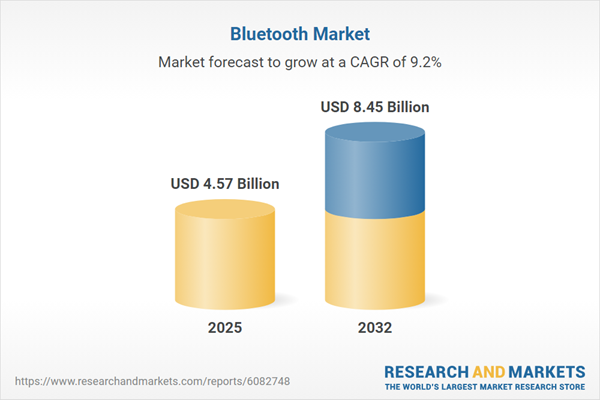Speak directly to the analyst to clarify any post sales queries you may have.
The Bluetooth market drives global wireless integration, offering essential connectivity and supporting innovation in diverse industries. Senior executives rely on current market research to inform investments, foster resilience, and identify emerging opportunities in an evolving ecosystem.
Market Snapshot: Bluetooth Market Size and Growth Trends
The Bluetooth market has shown robust expansion, increasing from USD 4.18 billion in 2024 to USD 4.57 billion in 2025, and is forecast to reach USD 8.45 billion by 2032, at a compound annual growth rate (CAGR) of 9.17%. This sustained growth is propelled by rapid adoption of Bluetooth-enabled devices in both industrial and consumer sectors. Advancements in wireless standards, heightened demand for efficient solutions, and intensive deployment within the Internet of Things (IoT) ecosystem support continued innovation. Manufacturers meet diverse sector requirements by frequently introducing new features and addressing evolving connectivity needs.
Scope & Segmentation of the Bluetooth Market
- Technology: Bluetooth Classic enables reliable audio streaming and seamless device connectivity for business and consumer use. Bluetooth Low Energy is purpose-built for applications requiring minimal energy, such as wearables and health monitoring, and extends to versions 4.0, 4.2, and 5.0. Bluetooth Mesh supports large-scale sensor networks within smart buildings and complex industrial environments, enabling scalable, robust communication models.
- Range: Class 1 devices serve industrial telemetry, offering extended reach for asset tracking. Class 2 balances reach and power efficiency, making it the standard for most consumer electronics. Class 3 is suited for compact accessories and wearable devices, where conserving battery life and supporting short-range operations are prioritized.
- Application: Bluetooth is integral to automotive infotainment and telematics, enhancing both usability and operational insight. It enables simple device pairing in consumer electronics such as headsets, smartphones, and computer peripherals. Healthcare environments adopt Bluetooth for remote diagnostics and continuous patient monitoring, while industrial settings rely on wireless protocol for streamlined automation and efficient sensor networks.
- Regions: The Americas include the US, Canada, Mexico, and multiple Latin American countries such as Brazil and Argentina, providing broad regional diversity. EMEA spans Western and Eastern Europe, Middle Eastern technology hubs, and developing economies across Africa, reflecting a mix of mature and high-growth markets. Asia-Pacific features leading technology exporters and rapidly expanding digital markets, including China, India, Japan, South Korea, and Southeast Asia.
- Key Companies Monitored: Comprehensive analysis includes major players such as Qualcomm Incorporated, Broadcom Inc., MediaTek Inc., Texas Instruments Incorporated, STMicroelectronics N.V., NXP Semiconductors N.V., Infineon Technologies AG, Nordic Semiconductor ASA, Microchip Technology Incorporated, and Silicon Laboratories Inc., who actively shape market direction through R&D and partnerships.
Key Takeaways for Senior Decision Makers
- Bluetooth functions as foundational infrastructure for contemporary IoT applications in industrial, automotive, and healthcare segments, connecting devices while supporting scalable deployments.
- Recent advancements, notably Bluetooth Low Energy and Mesh networking, are enabling energy-saving solutions that support larger, interconnected environments designed for future growth.
- Original Equipment Manufacturers (OEMs) streamline time-to-market for connected products using system-on-chip Bluetooth solutions, leading to simplified development and integration.
- Deployment and adoption strategies are shaped by regional regulations, economic policy, and local preferences, requiring nuanced approaches for market entry across global territories.
- Market leaders centrally manage diverse portfolios and form strategic alliances, balancing continuous innovation with a focus on operational agility in dynamic conditions.
Impact of 2025 U.S. Tariffs on Bluetooth Market Dynamics
U.S. tariffs introduced in 2025 created cost and sourcing challenges in the Bluetooth supply chain. To maintain flexibility, enterprises diversified their supplier networks, evaluated shifts toward alternative production regions, and considered leveraging local manufacturing assets. These tactics improved supply chain resilience, encouraged vertical integration, and prompted wider use of modular designs, allowing rapid adjustment to fluctuations in component availability.
Market Research Methodology & Data Sources
This market analysis is informed by in-depth interviews with suppliers and system integrators, reinforced with extensive secondary research including industry publications and regulatory filings. Thorough validation processes and peer benchmarking ensure the depth, reliability, and actionable value of findings.
Why This Report Matters: Strategic Benefits
- Enables executives to recognize Bluetooth’s pivotal role in both established and nascent segments such as industrial automation, connected vehicles, and healthcare monitoring.
- Provides targeted guidance to anticipate market shifts, mitigate risks from supply disruptions, and adapt operational strategies to evolving geopolitical or regulatory pressures.
- Supplies frameworks to align product portfolios and innovation pipelines with upcoming opportunities and industry transitions.
Conclusion
Bluetooth continues to underpin wireless connectivity for global industries. Forward-thinking research and sustained technological development empower organizations to navigate change and capitalize on emerging trends.
Table of Contents
3. Executive Summary
4. Market Overview
7. Cumulative Impact of Artificial Intelligence 2025
Companies Mentioned
The companies profiled in this Bluetooth market report include:- Qualcomm Incorporated
- Broadcom Inc.
- MediaTek Inc.
- Texas Instruments Incorporated
- STMicroelectronics N.V.
- NXP Semiconductors N.V.
- Infineon Technologies AG
- Nordic Semiconductor ASA
- Microchip Technology Incorporated
- Silicon Laboratories Inc.
Table Information
| Report Attribute | Details |
|---|---|
| No. of Pages | 192 |
| Published | October 2025 |
| Forecast Period | 2025 - 2032 |
| Estimated Market Value ( USD | $ 4.57 Billion |
| Forecasted Market Value ( USD | $ 8.45 Billion |
| Compound Annual Growth Rate | 9.1% |
| Regions Covered | Global |
| No. of Companies Mentioned | 11 |









